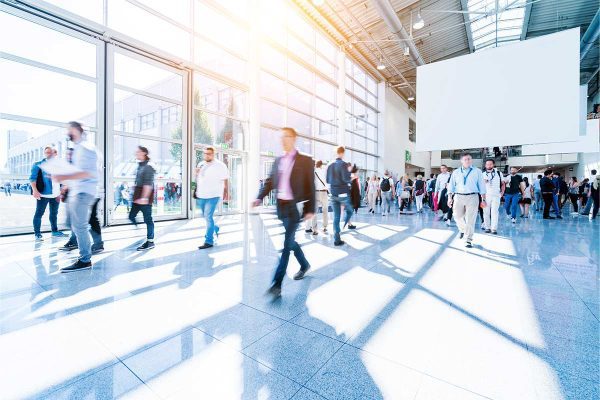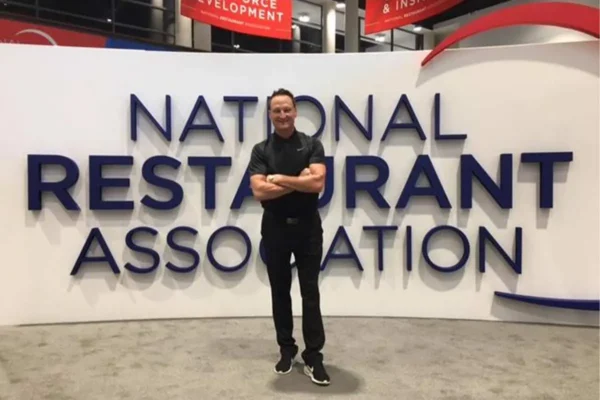In this article, we are going to explore key differences in exhibiting in North America vs. the rest of the world. It’s easy to assume simple things like flooring, laminate and fabric would have the same options available anywhere in the world. However, this is not the case. Actually, we are the odd duck. The rest of the world builds exhibits more similarly to each other than to North America.
 Flooring: Yes, raised flooring is normal and many times required at international shows. I know people on this side of the pond hate hearing that, but it’s not a bad thing. Due to the fact many countries do not allow electricity to be run directly under the carpet, people use a raised floor instead of trying to find a way to hide cables overhead. Plus, it’s very expensive to use the nice, plush carpet and padding we have here. The thin indoor-outdoor carpet is more like it, so having that raised floor saves your feet and back a smidge when standing all day.
Flooring: Yes, raised flooring is normal and many times required at international shows. I know people on this side of the pond hate hearing that, but it’s not a bad thing. Due to the fact many countries do not allow electricity to be run directly under the carpet, people use a raised floor instead of trying to find a way to hide cables overhead. Plus, it’s very expensive to use the nice, plush carpet and padding we have here. The thin indoor-outdoor carpet is more like it, so having that raised floor saves your feet and back a smidge when standing all day.
Laminate: When designing an exhibit for overseas, keep in mind that just because we have, for example, an Italian laminate in the U.S. for use, it doesn’t mean it’s actually available in Europe or anywhere else in the world for that matter. It’s always important to find a local catalogue of available material finishes. Also, keep in mind, painting is more common, and therefore, usually more cost-effective.
Plywood vs. MDF: Because it is less expensive, MDF is used in the rest of the world for building panels. Plywood is used in North America, more commonly, because, while it is has a higher price tag, it is lighter and saves money over the long run in drayage costs. Since we tend to re-use our exhibits here for years, that makes sense. But, due to the lack of drayage charges in most other countries, the lightness is a moot point and using MDF will save you money on your build. The other great thing about MDF is, if you like laminate more than paint, they have stock pre-laminated MDF panels. These are cost-effective and a great solution for laminate.
Fabric: The options for fabric use in North America are mind-blowing. Due to the ease of putting up fabric and the lightness compared to wood and other materials, North America is seeing a huge amount of fabric in exhibits these days. Unfortunately, many of these options are not available in the rest of the world. Europe is expanding its fabric offerings. But in places like the UAE, India, China and Brazil (emerging markets in general), using fabric on-site just doesn’t make sense most of the time. Therefore, there is not a huge push to start adding more options. Due to the fact that they build the majority of the stand on-site and have saws and paint everywhere, your fabric is going to get dirty – and fast. Since cleaning fabric once it is put up is difficult, you’ll likely end up going through the show with a visibly dirty stand.
Labor: Most exhibit builders in the rest of the world use their own labor teams to install and dismantle. This means paying for an entire crew to travel to the show location if it isn’t in their hometown and incurring travel expenses. Labor networks, like we have in North America, are not common. Therefore, install-and-dismantle labor likely is going to be more expensive than what you are used to in the U.S. or Canada, especially if you are using a stand builder in Germany for a show in Italy or the U.K. or someone in Rio de Janeiro for a show in Sao Paulo.
Waste Disposal: Now, I shouldn’t talk too loudly about this one, but this is a fee the rest of the world has that North America doesn’t. Since most stands are build-and-burns, they charge a fee to dispose of the properties when the show is over. Expect to see this on your estimates and invoices when you leave the country.
While sometimes these differences can be painful (umm … no carpet padding!) and a bit of nuisance, it’s best to embrace them instead of fight them. Any time you leave your home country, something is different. And when you can accept and maybe even learn from it, it makes the experience all the better.
Kelli Steckbauer is the director of global business for MG Design, an exhibit design, event planning and management services provider.






























